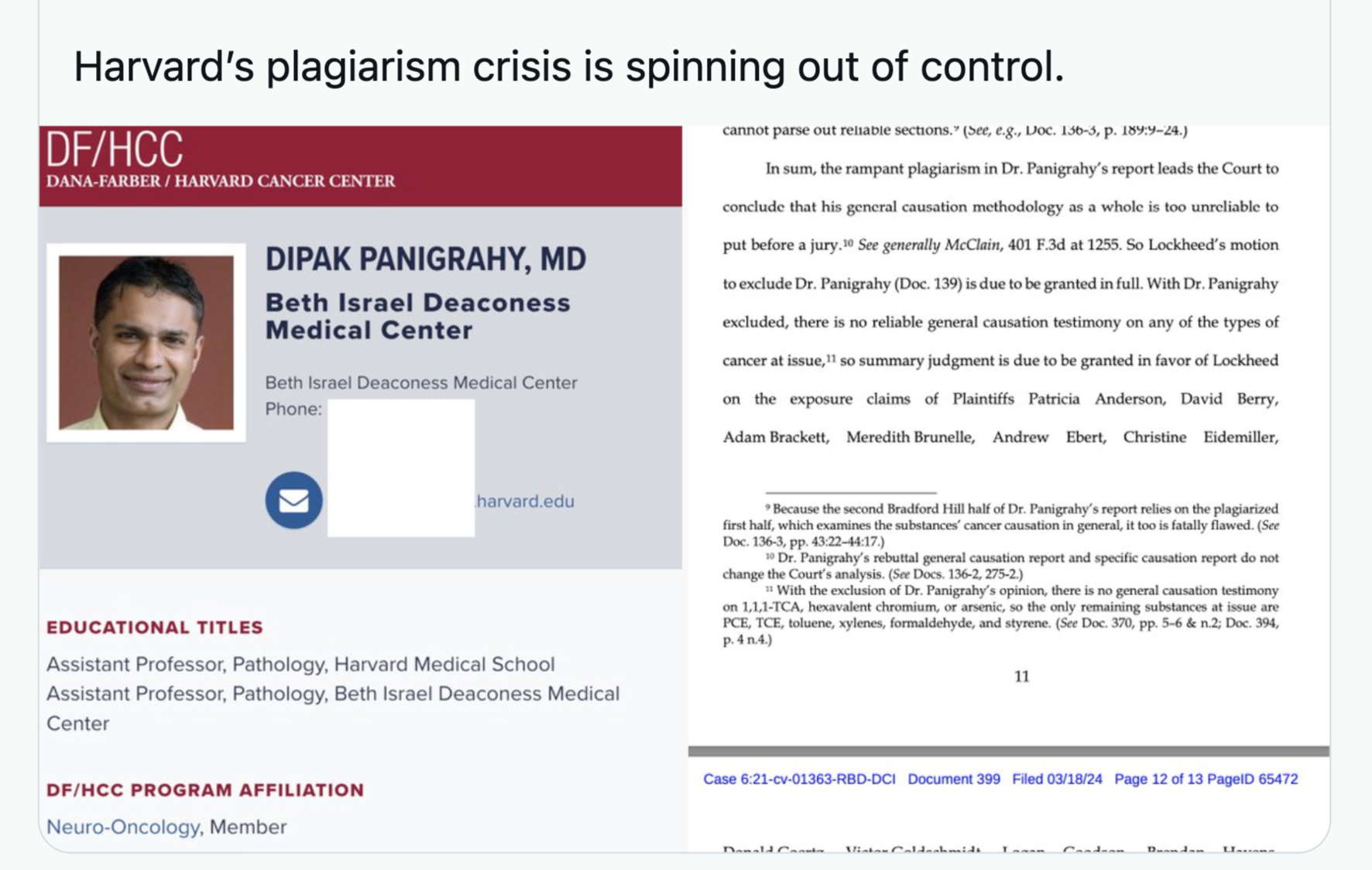Well, Harvard
/Harvard Medical “Expert” Disqualified in Federal Court Case Due to “Overwhelming” and “Misleading” Plagiarism
Judge Roy Dalton, in Orlando federal court, on March 18 granted Lockheed Martin’s motion to exclude the testimony of Dr. Dipak Panigrahy, a pathologist who was to testify that seven substances released at an Orlando plant can cause eight types of cancer that affect 22 plaintiffs in the lawsuit….
Panigrahy’s testimony alleged TCE, PCE, HCHO, arsenic, hexavalent chromium, trichloroethylene and styrene could cause these cancers: kidney, breast, thyroid, pancreatic, liver and bile duct, testicular, anal, Hodgkin’s lymphoma, non-Hodgkin’s lymphoma and leukemia.
“The problem was Panigrahy simply copied, without any attribution, large swaths of research produced by the International Agency for Research on Cancer (IARC). This, Judge Dalton determined, was deliberate Plagiarism:
“Here, there is no question that Dr. Panigrahy extensively plagiarized his report,” he added. A side-by-side comparison speaks for itself.
“And his deposition made the plagiarism appear deliberate, as he repeatedly outright refused to acknowledge the long swaths of his report that quote other work verbatim without any quotation marks at all – instead stubbornly insisting that he cited over 1,100 references, as if that resolves the attribution issue (it does not).”
This plagiarism demonstrates an unreliable methodology, Dalton found.
“Indeed, the plagiarism is so ubiquitous throughout the report that it is frankly overwhelming to try to make heads or tails of just what is Dr. Panigrahy’s own work – a task that neither he nor Plaintiffs’ counsel even attempts to tackle,” he wrote.
“More importantly, Dr. Panigrahy took the stolen research and deleted cautionary references, thereby making it look worse than it was. [bolding added] From Judge Dalton’s Disqualification Order:
Again, the Court could end there. But the report gets worse—because Dr. Panigrahy did not just lift from IARC without alteration. Rather, several times, he copied lengthy paragraphs from IARC verbatim but conveniently left out sentences in which IARC urged caution about the limitations of its findings, misleadingly presenting the science as more definitive than it actually is…Copying from IARC is bad enough, but selectively copying to overstate the science makes Dr. Panigrahy’s methodology even less reliable…And because Dr. Panigrahy did not actually put quotation marks around what he was lifting from IARC, it would be a near impossible task to try to find every instance in his 500-page report where he went even further than IARC would by omitting its cautionary language, so the Court cannot parse out reliable sections.”
Judge Dalton summed up:
In sum, the rampant plagiarism in Dr. Panigrahy’s report leads the Court to conclude that his general causation methodology as a whole is too unreliable to put before a jury. So Lockheed’s motion to exclude Dr. Panigrahy is due to be granted in full. With Dr. Panigrahy excluded, there is no reliable general causation testimony on any of the types of cancer at issue, so summary judgment is due to be granted in favor of Lockheed on the exposure claims of [22] Plaintiffs.
Dr. Panigrahy’s report was so bad that it made Nathan Schachtman’s Wall of Shame blog, who went over the Lockheed case, Dipak Panigrahy – Expert Witness & Putative Plagiarist, and then noted Dr. Panigrahy’s current job title:
The putative plagiarist, Dr. Panigraphy, is an assistant professor of pathology, at Harvard Medical School, in the department of pathology, Beth Israel Deaconess Medical Center, in Boston.
One piece of good news for Dr. Panigraphy. there are currently openings at Harvard’s DEI and president’s office — he sounds perfect for either position.


